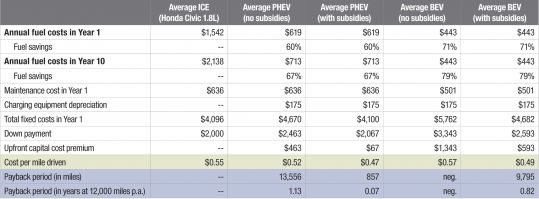This is the final piece in a four-part series offering insights and perspectives from GTM Research's latest Smart Grid report, Electric Vehicles 2011: Technology, Economics, and Market. To read part one, click here. Part two is here; part three, here.
Electric vehicles are too expensive.
This is one of the most persistent arguments against the widespread electrification of personal transport. But is it true? The 2012 models of the Chevy Volt and Nissan LEAF come with hefty price tags of $39,995 and $35,200, respectively, which is indeed considerably more than their conventional counterparts. However, upfront retail cost is only one part of the picture. An accurate determination of the relative economic value of electric vehicles (EVs) versus conventional vehicles requires consideration of the total cost of ownership (TCO).
TCO, measured in dollars per mile driven, considers the cost of acquisition, disposal, and operation of a vehicle over its lifetime. It can also take into account third-party financing (e.g., a car loan), which converts an upfront cost into an amortized series of payments over time. In the table below, the TCO for currently available EVs is compared to a baseline car with an internal combustion engine (ICE).
Figure: Total Cost of Ownership for Stylized Vehicles
Source: GTM Research
These calculations are based on the following conditions:
- Price of vehicles (2011 models; before subsidies): $20,000 Honda Civic, $32,800 Nissan LEAF, $27,990 Mitsubishi iMiEV, $41,000 Chevy Volt, $24,520 Toyota Prius
- Average travel distance per year: 12,000 miles
- Tax credit applied to BEVs and PHEVs: $2,500 for first 4 kilowatt-hour of battery capacity, then $417 for each incremental kilowatt-hour of capacity, capped at $7,500
- Holding period: 10 years, with 20 percent scrap value
- Financing: car loan at 6 percent interest, 10% down payment
- Fuel price: $3.74 per gallon of gasoline (growing at 3.7 percent annually), and $0.108 per kilowatt-hour (no growth)
It should be noted that with the exception of the Chevy Volt, all of the EVs have a lower cost per mile than a conventional ICE. This is, however, taking into account the federal subsidy of $7,500. Without this subsidy, the payback period increases from under one year to about 6.5 years, which exceeds the two- to three-year payback period consumers typically demand. So EVs are more expensive than conventional cars, right?
Not necessarily. In the above analysis, the models under consideration are not necessarily comparable in terms of design and performance. Due to variations in size, quality, safety, brand, and driving range, compounded by different manufacturer costs and profits, we are in fact comparing apples to oranges. The Chevy Volt, for instance, is clearly in a different vehicle category than the Honda Civic 1.8L. As GTM Research demonstrates in its latest report, Electric Vehicles 2011: Technology, Economics, and Market, when EVs are compared to vehicles in the same class, they suddenly become more favorable, achieving payback periods of a little more than one year -- without subsidies.
How is this possible? Principally for two reasons. First, the gasoline/electricity spread is expected to widen over the coming decade, mainly driven by higher oil prices. At the same time, battery costs are expected to fall significantly below their current level of $500 to $750/kWh. Even though these two effects will be partly offset by the improved fuel economy of ICEs, the net effect will ensure that EVs will become more competitive in the future.
Second, third-party financing converts a higher upfront capital cost to a series of payments in the future. The effect of discounting reduces the cost penalty of EVs significantly, and it cannot be overstated how important third-party financing is for achieving cost parity quickly.
So are EVs actually more expensive than ICEs? We believe not, based on TCO as the most accurate financial metric with which to evaluate a car purchase. Whether or not consumers take these considerations into account when buying a new car, and what car manufacturers can learn from this analysis, is explored in detail in our report, Electric Vehicles 2011: Technology, Economics, and Market.




